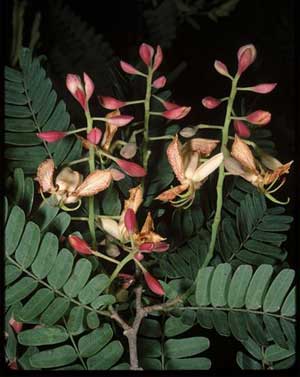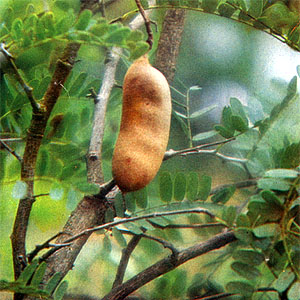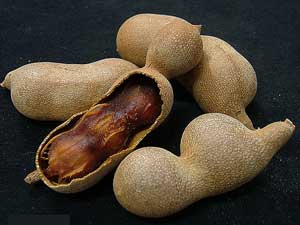Contents:
Common Names | Parts Usually Used | Plant(s) & Culture | Where Found | Medicinal Properties
Legends, Myths and Stories | Uses | Formulas or Dosages | Bibliography
Scientific Names

- Tamarindus indica L.
- Caesalpinia family
Common Names
- Au-mi-lo (Chinese name)
Parts Usually Used
Fruit, leaves
Back to Top
Description of Plant(s) and Culture

Tamarind is an evergreen tree; it grows up to 80 feet high; its trunk, covered with shaggy, brownish-gray bark, may reach 25 feet in diameter. The alternate, even-pinnate leaves have from 2- to 40 small, opposite, oblong leaflets. The pale yellow flowers have petals with red veins and grow in racemes at the ends of the branches. Flowering time in the northern hemisphere is during April and May. The fruit is a cinnamon-colored oblong pod, from 3 to 8 inches long, with a thin, brittle shell enclosing a soft, brownish, acidulous pulp.
Back to Top
Where Found
Found in tropical climates.
Back to Top
Medicinal Properties
Anthelmintic, laxative, refrigerant
Back to Top
Legends, Myths and Stories

Tamarind is a tropical tree of India bearing pods with a sweetish sour soft brown pulp. This pulp contains considerable proportion of tartaric acid and invert sugar.
In the Orient a brine is made of the pulp for pickling fish, and an acid jelly made to serve with fish and cold meats. Rice cooked with Tamarind pulp is also eaten with fish or meats.
Back to Top
Uses
The fruit is a mild laxative. In the tropics, it is commonly eaten as a food and made into cooling beverages. It makes a refreshing drink for those ill with a fever. The natives of the tropics use the leaves externally in a form of poultice or fomentation. A small amount of the pulp of the fruit, mixed with Cassia fistula and the powder of Rhubarb is a refreshing drink and an appetite stimulant. As a laxative, Tamarind pulp is usually used with Senna to modify the action of the latter.
Back to Top
Formulas or Dosages
Tamarind Whey: mix 1 oz. pulp of the fruit with 1 pint of milk, strain it and add a little sugar to the whey.
Tamarind Beverage: boil 3 pints of water with a teacup of tamarinds, a few currants and raisins until it has evaporated 1/3. Strain and cool.
Tamarind Marmalade: 1 qt. shelled tamarind nuts, water, sugar. Boil tamarinds in plenty of water until soft. Put through sieve to remove seeds and fibers. Measure equal parts of sugar and pulp and simmer slowly, stirring constantly until the mixture thickens enough to coat a silver spoon. Pour into sterilized jelly glasses and seal with wax.
Back to Top
Bibliography
![]() The Herbalist Almanac
The Herbalist Almanac, by Clarence Meyer, Meyerbooks, publisher, PO Box 427, Glenwood, Illinois 60425, copyright 1988, fifth printing, 1994
![]() Chinese Medicinal Herbs
Chinese Medicinal Herbs, compiled by Shih-Chen Li, Georgetown Press, San Francisco, California, 1973.
![]() The Herb Book
The Herb Book, by John Lust, Bantam Books, 666 Fifth Avenue, New York, NY. copyright 1974.
![]() The Yoga of Herbs: An Ayurvedic Guide to Herbal Medicine
The Yoga of Herbs: An Ayurvedic Guide to Herbal Medicine, by Dr. David Frawley & Dr. Vasant Lad, Lotus Press, Twin Lakes, Wisconsin, Second edition, 1988.
![]() Webster’s New World Dictionary
Webster’s New World Dictionary, Third College Edition, Victoria Neufeldt, Editor in Chief, New World Dictionaries: A Division of Simon & Schuster, Inc., 15 Columbus Circle, New York, NY 10023
